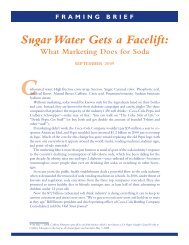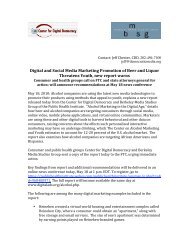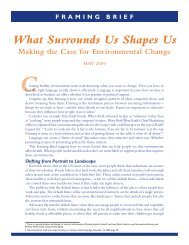"Interactive Food & Beverage Marketing" (PDF)
"Interactive Food & Beverage Marketing" (PDF)
"Interactive Food & Beverage Marketing" (PDF)
Create successful ePaper yourself
Turn your PDF publications into a flip-book with our unique Google optimized e-Paper software.
10<br />
<strong>Interactive</strong> <strong>Food</strong> & <strong>Beverage</strong> Marketing | Setting the Stage<br />
Government agencies, public health professionals, and consumer groups have<br />
become increasingly concerned over the role of advertising in promoting “high-calorie,<br />
low-nutrient” products to young people. 9 In 2004, the Centers for Disease Control and<br />
Prevention, under a Congressional mandate, commissioned the Institute of Medicine to<br />
conduct a comprehensive examination of the role of marketing in children’s food consumption.<br />
Based on an analysis of hundreds of studies, the 2005 report, <strong>Food</strong> Marketing<br />
to Children and Youth: Threat or Opportunity?, found that “among many factors, food and<br />
beverage marketing influences the preferences and purchase requests of children, influences<br />
consumption at least in the short term, and is a likely contributor to less healthful<br />
diets, and may contribute to negative diet-related health outcomes and risks among children<br />
and youth.” 10 The study’s recommendations included a strong warning to the food<br />
industry to change its advertising practices. “If voluntary efforts related to advertising during<br />
children’s television programming are not successful in shifting the emphasis away<br />
from high-calorie and low-nutrient foods and beverages to the advertising of healthful<br />
foods and beverages,” the report said, “Congress should enact legislation mandating the<br />
shift on both broadcast and cable television.” 11<br />
Further government inquiries, public hearings, and press coverage have continued<br />
to focus attention on this issue. The Federal Trade Commission and the U.S.<br />
Department of Health and Human Services held a series of workshops with industry and<br />
consumer groups, issuing a report in 2006 that urged food and beverage companies to<br />
engage in more responsible production, packaging, and marketing practices, including<br />
developing products that are “lower in calories, more nutritious, more appealing to children,<br />
and more convenient to prepare and eat.” 12 In February 2007, the Federal<br />
Communications Commission announced the establishment of a Task Force on Media &<br />
Childhood Obesity, comprising food and ad industry representatives, consumer groups,<br />
and health experts. The goal of the Task Force is to “build consensus regarding voluntary<br />
steps and goals that the public and private sectors can take to combat childhood obesity.”<br />
13<br />
Last year, the Center for Science in the Public Interest (CSPI) and the Campaign<br />
for a Commercial-Free Childhood (CCFC) announced their intent to file a suit against both<br />
the Kellogg Company and Viacom, the corporate owner of Nickelodeon. The announcement<br />
charged the companies with “directly harming kids’ health” because “the overwhelming<br />
majority of food products they market to children are high in sugar, saturated<br />
and trans fat, or salt, or almost devoid of nutrients.” The groups said they would “ask a<br />
Massachusetts court to enjoin the companies from marketing junk foods to audiences<br />
where 15 percent or more of the audience is under age eight, and to cease marketing<br />
junk foods through websites, toy giveaways, contests, and other techniques aimed at that<br />
age group.” 14









